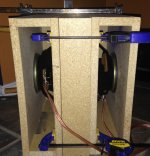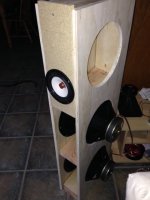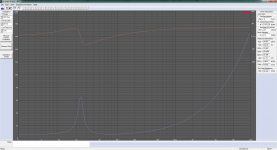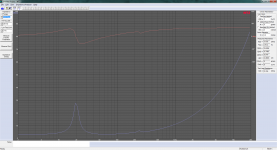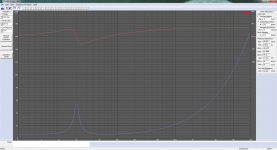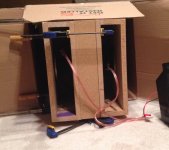I am having a little trouble understanding Pic3.
Looks to me at 20V, the cone moves 10meters.
Bad as excursion can be, I don't think its quite
that bad...
If it was supposed to mean 10mm, the last one
I saw (zob's #3, not the latest incarnation #4)
did not exhibit even that much cone control.
In your other screenshots, 1m appears to mean
unambiguously 1 meter. What does 1m mean in
the excursion graph?
Looks to me at 20V, the cone moves 10meters.
Bad as excursion can be, I don't think its quite
that bad...
If it was supposed to mean 10mm, the last one
I saw (zob's #3, not the latest incarnation #4)
did not exhibit even that much cone control.
In your other screenshots, 1m appears to mean
unambiguously 1 meter. What does 1m mean in
the excursion graph?
Re: Face Post #37
Harman lists sensitivity of that 4ohm woofer at 92dB/1W and 96dB/2.83V.
So by which method of drive did you measure over 100dB for the pair?
and would you care to step back to 2m, then 3m, and document the rate
of dropoff as we exit the near field.
----
Zob has the calibrated mic, and I have the WT3. So he can measure the
Ripole (after the glue dries he said) , but not the driver. WT3 measures
of the driver won't be sooner than Friday, unless maybe he wants to meet
me at work and pick it up on some earlier schedule.
Harman lists sensitivity of that 4ohm woofer at 92dB/1W and 96dB/2.83V.
So by which method of drive did you measure over 100dB for the pair?
and would you care to step back to 2m, then 3m, and document the rate
of dropoff as we exit the near field.
----
Zob has the calibrated mic, and I have the WT3. So he can measure the
Ripole (after the glue dries he said) , but not the driver. WT3 measures
of the driver won't be sooner than Friday, unless maybe he wants to meet
me at work and pick it up on some earlier schedule.
Last edited:
I didn't have a lot of time to test yesterday evening but did manage to fire it up.
Like my previous trials, The ripole barely works. Hard to make out a difference with music with a 100 watt sub plate amp almost maxed out. And turning the volume up even more hits the excursion limits. Listening to a test sweep, what noise it did produce was good quality, though .
I'm not going to make any judgements based on my preliminary gets this time. Maybe it was in a suckout zone (which I strngoy suspect is at least partially true). Maybe the drivers were not blowing and sucking in symphony(I doubt it, but will double check). Maybe ....
I'll test this design objectively
Like my previous trials, The ripole barely works. Hard to make out a difference with music with a 100 watt sub plate amp almost maxed out. And turning the volume up even more hits the excursion limits. Listening to a test sweep, what noise it did produce was good quality, though .
I'm not going to make any judgements based on my preliminary gets this time. Maybe it was in a suckout zone (which I strngoy suspect is at least partially true). Maybe the drivers were not blowing and sucking in symphony(I doubt it, but will double check). Maybe ....
I'll test this design objectively
Attachments
Last edited:
For the record.
I did try positioning the ripole both with the back facing the listener vs with the front facing the listener and trying the plate amp phase switch in NORMAL vs REVERSE in both positions . Not a lot of difference.
How do people who have had success with this design recommend placing it i.e. far field like most subs or near field (like a side table, for example) .
I did try positioning the ripole both with the back facing the listener vs with the front facing the listener and trying the plate amp phase switch in NORMAL vs REVERSE in both positions . Not a lot of difference.
How do people who have had success with this design recommend placing it i.e. far field like most subs or near field (like a side table, for example) .
I cannot understand why you guys are having such a problem. My Ripoles are immediately adjacent to my Line Arrays in a traditional, more or less, equilateral triangle. They are 3 meters apart and have the single slot side facing towards the listening position and the bass they put out is very much on par with my Linn Isobarik's only more detailed and deeper. Perhaps I got lucky with the room nodes where my listening position is?
I do use eq. and the gain is up for the Ripoles against the Line Arrays but the amps are only 60 per channel and the gain is only half way for them.
The 12 driver arrays are running at around 99db/watt and the 12" bass drivers are 96db/watt each so 99db/watt for each Ripole less inefficiencies but made up for by the increase in gain. The arrays are running fullrange with no crossover and the Ripoles are rolled off at about 100Hz at 12 db. This needs more work but they sound awesome. Full active crossover to follow.
I do use eq. and the gain is up for the Ripoles against the Line Arrays but the amps are only 60 per channel and the gain is only half way for them.
The 12 driver arrays are running at around 99db/watt and the 12" bass drivers are 96db/watt each so 99db/watt for each Ripole less inefficiencies but made up for by the increase in gain. The arrays are running fullrange with no crossover and the Ripoles are rolled off at about 100Hz at 12 db. This needs more work but they sound awesome. Full active crossover to follow.
Hi,
Ken, Your Q regrding Pic#3:
10mm is the right value.
I know this buggy behaviour of Akabak
jauu
Calvin
Ken, Your Q regrding Pic#3:
10mm is the right value.
I know this buggy behaviour of Akabak
jauu
Calvin
HiHi zobsky,
I hate to even ask, but are you sure that the drivers are properly phased?
Regards,
That is one of the things I intend to verify the next time I verify.
Thanks
I think we can build a 4 sided box (top, left, right, back) and set
it over the test ripole (without touching anything but the floor)
to re-purpose it as a PPSL 6th order bandpass. Slide the cover
box back and forth and/or reduce the interior with a bucket of
water to dial-in the stagger tuning for minimal cancellation.
4th order has a better chance of success, but we'd have to totally
seal the box to one end or other of the manifold, and would be no
internal access to tune the compliance of it without an added door.
I'm lazy, lets just go 6th. Plan C being Viking funeral of course...
Its not like Ripole sets a high bar for another alignment to best.
We could build a sealed wind tunnel with no exit and claim that
it couples circularly polarized bass outside by frame dragging.
Wether or not that works efficiently isn't the issue, only how
much should we charge for the plans?
---
When the woofer count was 6, we verified the phasing, twice.
it over the test ripole (without touching anything but the floor)
to re-purpose it as a PPSL 6th order bandpass. Slide the cover
box back and forth and/or reduce the interior with a bucket of
water to dial-in the stagger tuning for minimal cancellation.
4th order has a better chance of success, but we'd have to totally
seal the box to one end or other of the manifold, and would be no
internal access to tune the compliance of it without an added door.
I'm lazy, lets just go 6th. Plan C being Viking funeral of course...
Its not like Ripole sets a high bar for another alignment to best.
We could build a sealed wind tunnel with no exit and claim that
it couples circularly polarized bass outside by frame dragging.
Wether or not that works efficiently isn't the issue, only how
much should we charge for the plans?
---
When the woofer count was 6, we verified the phasing, twice.
Last edited:
I think we can build a 4 sided box (top, left, right, back) and set
it over the test ripole (without touching anything but the floor)
to re-purpose it as a PPSL 6th order bandpass. Slide the cover
box back and forth and/or reduce the interior with a bucket of
water to dial-in the stagger tuning for minimal cancellation.
4th order has a better chance of success, but we'd have to totally
seal the box to one end or other of the manifold, and would be no
internal access to tune the compliance of it without an added door.
I'm lazy, lets just go 6th. Plan C being Viking funeral of course...
Its not like Ripole sets a high bar for another alignment to best.
We could build a sealed wind tunnel with no exit and claim that
it couples circularly polarized bass outside by frame dragging.
Wether or not that works efficiently isn't the issue, only how
much should we charge for the plans?
---
When the woofer count was 6, we verified the phasing, twice.
My table saw switch started malfunctioning, just as I finished the last cuts for this project, .. always stuck in the ON position, so we may not be able to implement the alternatives till I have a chance to repair / replace it, unless you want to risk amputation to go along with the proposed viking funeral
I verified the phasing with a 9V battery. The woofers push towards each other with their terminals in parallel (4 ohm load total) and connected to the positive pole of the battery.
I dragged the ripole to a corner of the room and pointed it out at the diagonal and walked about the room. Better than last night but still not pretty. When I have some more time, maybe on the weekend, I promise some more rigorous tests and tests in different rooms. One of my test tracks tonight was Bela Fleck's Flight of the Cosmic Hippo. https://www.youtube.com/watch?v=1iYgf6PWYK8 .
Any other ripole owners care to subject their drivers to this at slightly above normal listening levels ?To summarize, it wasn't pretty when the bass overloaded the enclosure . The mains were some DIY low efficiency econowave speakers and the ripoles were crossed over at about 80 Hz . Amplification was a NAD C720BEE and source was a raspberry pi with an outboard USB DAC
BTW, Off topic but here's an image of the last SLOB I built, currently disassembled and in storage. With wings (not shown in pic) folded back and a mounting spacer for the wings to clear the driver magnets (also not in pic), it vaguely approximated a ripole. At the time of taking the pic, I removed the top two drivers and implemented a 2 way open baffle of sorts.
Attachments
Last edited:
Very successfully using ripoles myself I'm also wondering why some of you guys can't make it work correctly. If the three chambers are properly sealed (also the hole for the woofer magnets if possible), the dimensions are right, the woofers are suitable(!) and you take proper care of the nasty higher-frequency resonances, it is a very easy-to-build speaker with the best/cleanest bass I have heard so far.
I'm using mine linearly between 20(!) and 120 Hz for any music and home cinema and can't complain. I've never needed to drive them to their mechanical limit (electrically they just need about 100W to reach that) as they already go pretty loud. In all fairness, I'm using four of them in total (though only 10in woofers -> Peerless SLS10), stacked in pairs in a stereo setup and angled towards the listener.
The last point (speaker placement and orientation) is crucial for a ripole. I think without in-rooom measurements it will be very hard to figure out a good placement. At the very least they should be some distance away from the corner and often angled to not align with the room geometry (to avoid the worst of the room's modes). Though for some it works well to place them near a side wall with all chambers in parallel to the wall.
Can you guys provide some measurements from the mouth of the ripole (near field) and from the listening position? That should clear up some of the problems a little, especially the room's involvement.
Here's my build report for my Quad-Ripole (in German but the pics and measurements speak for themselves) if anybody's interested: Quad-Ripole Subwoofer
As you can see from the pics I built them from a spare sideboard (due to the glossy white finish that's hard to DIY) and I previously had an SVS SB12+ subwoofer (which was no slouch either, also for music). The ripoles match or best it in almost every aspect except perhaps raw output volume. The room modes are far less excited (is that the right word in English?) than with the SVS and the bass sounds overall tighter, more dynamic and especially more uniform.
As it was previously commented here, it's not as easy building a good ripole from any woofers one has "lying around" as it would be designing a suitable closed or BR enclosure for them.
I'm using mine linearly between 20(!) and 120 Hz for any music and home cinema and can't complain. I've never needed to drive them to their mechanical limit (electrically they just need about 100W to reach that) as they already go pretty loud. In all fairness, I'm using four of them in total (though only 10in woofers -> Peerless SLS10), stacked in pairs in a stereo setup and angled towards the listener.
The last point (speaker placement and orientation) is crucial for a ripole. I think without in-rooom measurements it will be very hard to figure out a good placement. At the very least they should be some distance away from the corner and often angled to not align with the room geometry (to avoid the worst of the room's modes). Though for some it works well to place them near a side wall with all chambers in parallel to the wall.
Can you guys provide some measurements from the mouth of the ripole (near field) and from the listening position? That should clear up some of the problems a little, especially the room's involvement.
Here's my build report for my Quad-Ripole (in German but the pics and measurements speak for themselves) if anybody's interested: Quad-Ripole Subwoofer
As you can see from the pics I built them from a spare sideboard (due to the glossy white finish that's hard to DIY) and I previously had an SVS SB12+ subwoofer (which was no slouch either, also for music). The ripoles match or best it in almost every aspect except perhaps raw output volume. The room modes are far less excited (is that the right word in English?) than with the SVS and the bass sounds overall tighter, more dynamic and especially more uniform.
As it was previously commented here, it's not as easy building a good ripole from any woofers one has "lying around" as it would be designing a suitable closed or BR enclosure for them.
Last edited:
hurz, Thanks for posting.
Compared to my 2 driver (12" (500 cm2 Sd, 5 mm Xmax) prototype, your build uses 8 drivers (10", 346 cm2 Sd, 8 mm Xmax),
Comparing swept displacement
My 2 driver ripole: 2 x (500 x 0.5) = 500 cm3
Your 8 driver ripole system: 8 x (346 x 0.8) = 2214 cm3 .
Based on the feedback on this thread, I'm beginning to form the opinion that one of the main criteria needed to successfully build a ripole system is to have a large amount of displacement on tap . As I might have mentioned earier in this thread, I had semi-respectable results the last time I built an open baffle bass array (with 8 - 12 drivers total) which probably approaches what you describe.
This seems to be essential, apart from other factors such as driver suitability, power handling etc . Additionally, the response (as exepcted) appearssomewhat cardoid, so even though the ripole looks ilke a box, placement and aiming need to be considered.
Hopefully, I will find some to evaluate the system some more this weekend. If it can work, the 2 driver ripole would make a compact system for a small room with a pair of bookshelf speakers.
Compared to my 2 driver (12" (500 cm2 Sd, 5 mm Xmax) prototype, your build uses 8 drivers (10", 346 cm2 Sd, 8 mm Xmax),
Comparing swept displacement
My 2 driver ripole: 2 x (500 x 0.5) = 500 cm3
Your 8 driver ripole system: 8 x (346 x 0.8) = 2214 cm3 .
Based on the feedback on this thread, I'm beginning to form the opinion that one of the main criteria needed to successfully build a ripole system is to have a large amount of displacement on tap . As I might have mentioned earier in this thread, I had semi-respectable results the last time I built an open baffle bass array (with 8 - 12 drivers total) which probably approaches what you describe.
This seems to be essential, apart from other factors such as driver suitability, power handling etc . Additionally, the response (as exepcted) appearssomewhat cardoid, so even though the ripole looks ilke a box, placement and aiming need to be considered.
Hopefully, I will find some to evaluate the system some more this weekend. If it can work, the 2 driver ripole would make a compact system for a small room with a pair of bookshelf speakers.
Last edited:
Yes, Xmax is critical for a ripole. 5mm is comparatively on the low side. Some people even used the Peerless XXLS woofers for such projects (Xmax +/- 12.5 mm). As you only need little power to significantly stress the woofers in a ripole mechanically, the more Xmax you can get, the better.
My example with 8 woofers provides significantly more surface area of course, which really helps the overall volume too. Plus I'm actively equalizing the ripoles via a miniDSP (which enables me to reach 20Hz in the first place). Leaving them as they are without heavy custom equalization would have also left me with unsatisfactory bass (but mostly due to my room modes) as you can see in this comparison of my final measurements:
http://mulb.org/sites/mulb.org/files/images/DIY/ripol/ripol_stereo_eq.jpg
My example with 8 woofers provides significantly more surface area of course, which really helps the overall volume too. Plus I'm actively equalizing the ripoles via a miniDSP (which enables me to reach 20Hz in the first place). Leaving them as they are without heavy custom equalization would have also left me with unsatisfactory bass (but mostly due to my room modes) as you can see in this comparison of my final measurements:
http://mulb.org/sites/mulb.org/files/images/DIY/ripol/ripol_stereo_eq.jpg
This evening, we ran impedance sweeps on the raw driver (zalytron 1201PL), the 2 driver ripole, and estimated the extra effective mass needed to drop the raw driver resonant frequency by the same amount as the ripole (65 g per driver).
The ripole dropped the resonant frequency of the raw driver about 4 Hz to 19.5 Hz
The ripole dropped the resonant frequency of the raw driver about 4 Hz to 19.5 Hz
Last edited:
Observations:
1. Listening in a much smaller ENCLOSED room (maybe 10 x 12 ft with a high 12 ft ceiling), the ripole performed better than in my previous experiments in larger, more open spaces. I used an inexpensive pair sony bookshelf speakers (normally my home theater rears) for mains sound. I brought the ripoles in about 60 Hz in this test.
2. The ripole was basically done at 30 Hz, with woofers flapping about like a fish out of water, with little sound to show for it. Above 30 Hz, the bass was clean and even with maybe a few room modes. When I run the measurement tests, I'll use an actual amplifier - as opposed to a plate amp, to be sure I'm not dealing with any plate amp boosts / high pass bass cut etc . I can use my minidspor a PC equalizer later on to smooth out the room modes.
3. We rigged a crude 6th order bandpass by placing the ripole in a cardboard box. This brought up the bass about 50 - 60 Hz but was more uneven overall
4. We rigged up a crude 4th order bandpass by sealing the rear section of the ripole against the carpet. This had roughly the same effect as 3, but at different frequencies.
5. Based on our experiments, I feel that to have a successful ripole system, a good amount of swept displacement and / or a small room is needed. This 2 driver ripole with modest subwoofers performed halfway respectable in a small room but would be hopeless in our main living area.
6. At this point, I might build another identical ripole after I fix my saw, .. A pair of 2 driver ripoles with these drivers should work "OK" in a small room . Ripole "merits" apart, I would not have considered this approach if I didn't have so many of these woofers lying about (literally, at this point).
Measurements, and DSP correction to follow, in subsequent posts.
Here's a pic of the 6th order Frankenstein
1. Listening in a much smaller ENCLOSED room (maybe 10 x 12 ft with a high 12 ft ceiling), the ripole performed better than in my previous experiments in larger, more open spaces. I used an inexpensive pair sony bookshelf speakers (normally my home theater rears) for mains sound. I brought the ripoles in about 60 Hz in this test.
2. The ripole was basically done at 30 Hz, with woofers flapping about like a fish out of water, with little sound to show for it. Above 30 Hz, the bass was clean and even with maybe a few room modes. When I run the measurement tests, I'll use an actual amplifier - as opposed to a plate amp, to be sure I'm not dealing with any plate amp boosts / high pass bass cut etc . I can use my minidspor a PC equalizer later on to smooth out the room modes.
3. We rigged a crude 6th order bandpass by placing the ripole in a cardboard box. This brought up the bass about 50 - 60 Hz but was more uneven overall
4. We rigged up a crude 4th order bandpass by sealing the rear section of the ripole against the carpet. This had roughly the same effect as 3, but at different frequencies.
5. Based on our experiments, I feel that to have a successful ripole system, a good amount of swept displacement and / or a small room is needed. This 2 driver ripole with modest subwoofers performed halfway respectable in a small room but would be hopeless in our main living area.
6. At this point, I might build another identical ripole after I fix my saw, .. A pair of 2 driver ripoles with these drivers should work "OK" in a small room . Ripole "merits" apart, I would not have considered this approach if I didn't have so many of these woofers lying about (literally, at this point).
Measurements, and DSP correction to follow, in subsequent posts.
Here's a pic of the 6th order Frankenstein
Attachments
Last edited:
- Status
- Not open for further replies.
- Home
- Loudspeakers
- Subwoofers
- Considering ripole, but are these drivers suitable?
